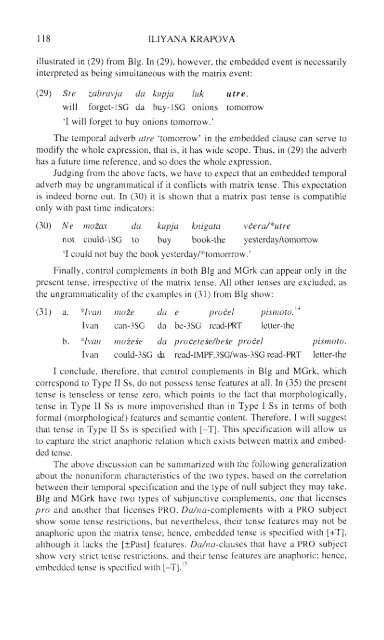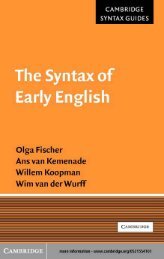Comparative Syntax of the Balkan Languages (Oxford ... - Cryptm.org
Comparative Syntax of the Balkan Languages (Oxford ... - Cryptm.org
Comparative Syntax of the Balkan Languages (Oxford ... - Cryptm.org
- No tags were found...
Create successful ePaper yourself
Turn your PDF publications into a flip-book with our unique Google optimized e-Paper software.
118 ILIYANA KRAPOVAillustrated in (29) from Big. In (29), however, <strong>the</strong> embedded event is necessarilyinterpreted as being simultaneous with <strong>the</strong> matrix event:(29) Sre zabravja da kupja luk utre.will f<strong>org</strong>et-lSG da buy-ISG onions tomorrow'I will f<strong>org</strong>et to buy onions tomorrow.'The temporal adverb litre 'tomorrow' in <strong>the</strong> embedded clause can serve tomodify <strong>the</strong> whole expression, that is, it has wide scope. Thus, in (29) <strong>the</strong> adverbhas a future time reference, and so does <strong>the</strong> whole expression.Judging from <strong>the</strong> above facts, we have to expect that an embedded temporaladverb may be ungrammatical if it conflicts with matrix tense. This expectationis indeed borne out. In (30) it is shown that a matrix past tense is compatibleonly with past time indicators:(30) Ne mozax da kupja knigata vcera/*utrenot could-1SG to buy book-<strong>the</strong> yesterday/tomorrowT could not buy <strong>the</strong> book yesterday/*tomorrrow.'Finally, control complements in both Blg and MGrk can appear only in <strong>the</strong>present tense, irrespective <strong>of</strong> <strong>the</strong> matrix tense. All o<strong>the</strong>r tenses are excluded, as<strong>the</strong> ungrammatically <strong>of</strong> <strong>the</strong> examples in (31) from Blg show:(31) a. *lvan moze da e procel pismoto.Ivan can-3SG da be-3SG read-PRT letter-<strong>the</strong>b. *Ivan mozese da procetese/bese procel pismoto.Ivan could-3SG da read-IMPF.3SG/was-3SG read-PRT letter-<strong>the</strong>I conclude, <strong>the</strong>refore, that control complements in Blg and MGrk, whichcorrespond to Type II Ss, do not possess tense features at all. In (35) <strong>the</strong> presenttense is tenseless or tense zero, which points to <strong>the</strong> fact that morphologically,tense in Type II Ss is more impoverished than in Type 1 Ss in terms <strong>of</strong> bothformal (morphological) features and semantic content. Therefore, I will suggestthat tense in Type II Ss is specified with [-T]. This specification will allow usto capture <strong>the</strong> strict anaphoric relation which exists between matrix and embeddedtense.The above discussion can be summarized with <strong>the</strong> following generalizationabout <strong>the</strong> nonuniform characteristics <strong>of</strong> <strong>the</strong> two types, based on <strong>the</strong> correlationbetween <strong>the</strong>ir temporal specification and <strong>the</strong> type <strong>of</strong> null subject <strong>the</strong>y may take.Big and MGrk have two types <strong>of</strong> subjunctive complements, one that licensespro and ano<strong>the</strong>r that licenses PRO. Da/na-complements with a PRO subjectshow some tense restrictions, but never<strong>the</strong>less, <strong>the</strong>ir tense features may not beanaphoric upon <strong>the</strong> matrix tense; hence, embedded tense is specified with [+T],although it lacks <strong>the</strong> [IPast] features. Da/na-clauses that have a PRO subjectshow very strict tense restrictions, and <strong>the</strong>ir tense features are anaphoric; hence,embedded tense is specified with [—TJ. 15
















